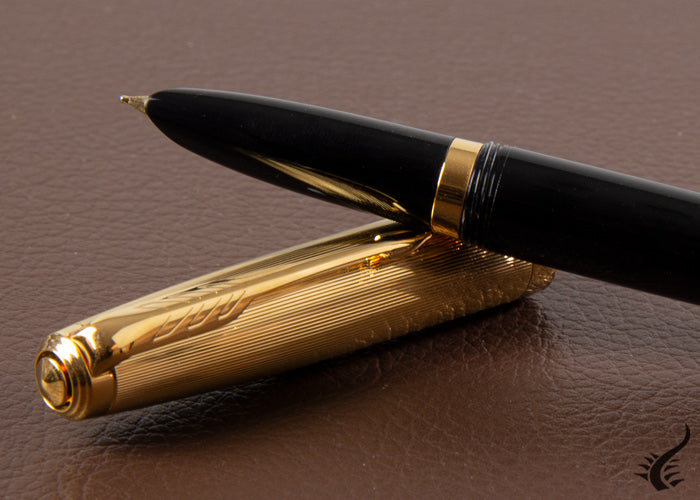Your Cart is Empty
Free shipping over £130 | HAPPY HOLIDAYS!
Free shipping over £130 | HAPPY HOLIDAYS!
The Pens That Ended World War II
April 28, 2023 3 min read

In 1945, the end of the worst war in human history was marked. Generals Eisenhower and MacArthur sealed the end of World War II with their Parker fountain pens in the signing of Germany's and Japan's surrender documents.
The Pens That Ended World War II
Parker was the most popular brand in the United States at the time. Founded in 1888 by George Safford Parker, it gained popularity in 1914, producing innovative designs that changed the market. In fact, both generals had their preferred model.
On 7 May 1945, Eisenhower signed the German Instrument of Surrender in Reims with a Parker 51. In September of the same year, MacArthur used a Parker Duofold, also very popular, and a design 20 years older.

Parker Big Red Duofold circa 1928. Wikimedia Commons
The Parker 51, launched in 1941 as the brand's 51st anniversary, had a more modern and refined design. It was in stark contrast to the Duofold, which was a large pen with bright colours such as red or orange.
In fact the Duofold was a very controversial model at the time and so the company decided to launch a replacement: the Vacumatic in 1933. However, the Duofold pen remained in production until the 1960s, as a sideline, and was revived in 1980. In 1988, as a celebration of the brand's 100th anniversary, they launched the Duofold Centenial, including rollers, pens and pencils.

Later they launched the Duofold International, also based on the classic Duofold design, but in a smaller version. These new versions changed the pen's feed system from a push-button filling mechanism to a cartridge or converter system.
The Parker 51 became extremely popular and continued in production until 1972. It was a revolutionary pen, which sought to solve all the problems that existed with fountain pens, and managed to become the best-selling pen in history, with the well-known slogan "The most wanted pen in the world". It was such a popular product that people who could not afford a Parker 51 were said to carry only the cap in their shirt pocket for show.

Its appearance imitated the P-51 Mustang aircraft used by the United States during the war, and with their engineering they managed to create a boom that would work under any circumstances. The original charging system was a piston system (which they had already used in the Vacumatic), then they changed it to an aerometric charging system. One of its most coveted features was that its ink dried on the paper, rather than the nib, and the grip area was made of plexiglass to limit misting. In 1972 the Parker 51 ceased production, but in 2021 it was re-released with an 18K or aluminium nib.
It is known that in the Act of Surrender of Japan, General Douglas MacArthur used a red 1928 Parker Duofold. However, the general actually used different fountain pens for each copy of the Instrument of Surrender of Japan; five of them were black and standard, and were issued to lieutenants. The Duofold was given to his wife.

At the German surrender at Rheims the pens used were Parker 51s, with the exception of a Schaeffer, which seems to have been a deliberate gift to Winston Churchill.l.
A curious fact is that although the Parker 51 pen used to sign the document belonged to Eisenhower, he was not actually in the room during the signing of the document. There was another ceremony on 9 May, which was rectified to that date.
Both pens symbolise a unique moment in history. MacArthur finished it with a Parker Duofold, in a dramatic, public and eye-catching event, like his fountain pen. Eisenhower, in a private, efficient and swift event, ended the war with a Parker 51.
Both pens were re-released, leaving these pieces of history at your fingertips.
If you have any questions please do not hesitate to contact our team, we will be happy to help you!
Leave a comment
Comments will be approved before showing up.
Also in News
Iguana | Blog
Recent Articles
- Esterbrook: synonymous with accessibility and quality
- Luminox: adventure watches for the most extreme challenges
- Watch complications: dials that make the difference
- Madrid Pen Show 2024
- Fountain Pen Day
- Discover Zeppelin Watches: Icons of Aviation and Classic Elegance
- Montblanc Watches: From Writing to the Art of Watchmaking
- The History of Nakaya Fountain Pens: Tradition and Luxury in Every Stroke
- Luxury Watch Investments: Is It Worth It?
- Pelikan Raden M1000 Black Infinity



